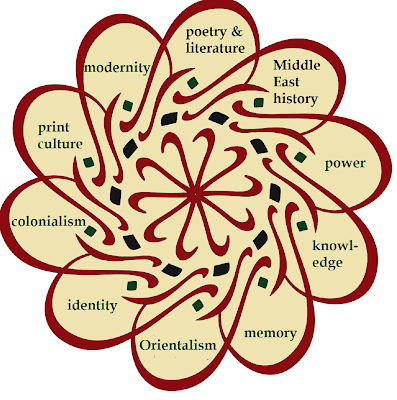So, here is my example of the bedraggled daisy exercise. It is
definitely bedraggled, but I am not sure I would call it a daisy.
Like it was said in class, it resembles more of a propeller. It
looks that way because Microsoft Paint does not seem to allow you to
rotate selections in degrees. So I used a shape tool to allow for
the angled “leaves” of the daisy. That is why my daisy is so
angular.
However, the angular design did give me a benefit. While drawing
the daisy, realized another category to fill in. I found that at one
point the daisy resembled a cross and I thought of the Christianity
category. I am not religious, but I know that my grandmother is, so
I am sure that it will be a topical part of the narrative. Since I
am not that religiously minded, I may have forgotten this category
had it not been for my angular daisy.
Genealogy is something that this project will definitely
encompass. A large part of the project is motivated by me wanting to
know more about my family's history to better understand myself. I
am sure that I will be doing a lot of exploring in my own family's
history.
The category “women” refers to my grandmother's experience as
a woman. Something that I am sure is relevant to her life, but I am
not sure how well I (as a man, and her grandson) will be able to
uncover (or understand) some of the details of this category. I have
heard some of her stories already, and some of them do relate to her
experience as a woman of that era, so it is something I may want to
explore.
History is a difficult category to define for this project. I am
sure that I will be covering the personal history of my grandmother.
But it is the larger history of the era that I am not sure about. I
will likely try to draw the two areas together by supplementing my
grandmother's oral account with other historical sources, in order to
give some context to her stories. This is just an idea.
I am not sure if I am cheating with the “War” category or not.
War is simply a fact of the era my grandmother lived in. So it
could be said to be part of the broader “History” category...I am
beginning to appreciate the plight of catalogers that we discuss in
our Knowledge Organization lectures... in any case, I think it is
relevant enough to warrant its own category, as war really shapes the
history and lives of the period that it occurs in.
Language and Ethnography relates to my grandmother's background,
and to the fact that ethnicity was an issue of the era. My
grandmother is Polish, so the project will encompass her experience
as a Pole during the German occupation, and also the struggles with
language during that period, and later on.
I left one petal blank because I was having a tough time coming up
with another category before the deadline...I will try to come back
to the daisy later to get another category filled in. But I would
also appreciate if anyone has a suggestion.







